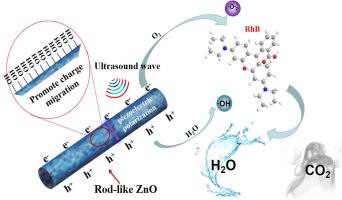Morphology effect on piezocatalytic performance of zinc oxide: Overlooked role of surface hydroxyl groups
IF 5.4
3区 化学
Q1 CHEMISTRY, INORGANIC & NUCLEAR
引用次数: 0
Abstract
As an environmentally friendly and non-toxic piezocatalyst, zinc oxide (ZnO) has been extensively utilized in treating organic wastewater, but the effect of surface hydroxyl (–OH) groups on the piezocatalytic activity of ZnO has not been sufficiently investigated. In this study, four ZnO catalysts with different microstructures (columnar-like, flake-like, rod-like, and flower-like) and surface –OH numbers have been fabricated for the catalytic degradation of rhodamine B. Rod-like ZnO possessed the highest number of surface –OH groups. Abundant surface –OH groups assist in suppressing electron–hole pair recombination and promoting charge migration, and thus, rod-like ZnO exhibited better piezocatalytic activity. Under ultrasonic vibration, rod-like ZnO catalyst degraded 95.2 % rhodamine B in 80 min. Holes and hydroxyl radicals were found to be the main reactive species during the piezocatalytic degradation process. The present study provides a novel idea for constructing ideal piezoelectric catalysts.

氧化锌的形态对压催化性能的影响:表面羟基被忽视的作用
氧化锌作为一种环保无毒的压电催化剂,在有机废水处理中得到了广泛的应用,但表面羟基(-OH)对氧化锌压电催化活性的影响尚未得到充分的研究。在本研究中,制备了四种不同微观结构(柱状、片状、棒状和花状)和表面-OH数目的ZnO催化剂,用于催化罗丹明b的降解。丰富的表面-OH基团有助于抑制电子-空穴对复合和促进电荷迁移,因此棒状ZnO具有更好的压催化活性。在超声振动下,棒状ZnO催化剂在80 min内降解了95.2%的罗丹明B。在压电催化降解过程中,空穴和羟基自由基是主要的活性物质。本研究为构建理想的压电催化剂提供了新的思路。
本文章由计算机程序翻译,如有差异,请以英文原文为准。
求助全文
约1分钟内获得全文
求助全文
来源期刊

Inorganic Chemistry Communications
化学-无机化学与核化学
CiteScore
5.50
自引率
7.90%
发文量
1013
审稿时长
53 days
期刊介绍:
Launched in January 1998, Inorganic Chemistry Communications is an international journal dedicated to the rapid publication of short communications in the major areas of inorganic, organometallic and supramolecular chemistry. Topics include synthetic and reaction chemistry, kinetics and mechanisms of reactions, bioinorganic chemistry, photochemistry and the use of metal and organometallic compounds in stoichiometric and catalytic synthesis or organic compounds.
 求助内容:
求助内容: 应助结果提醒方式:
应助结果提醒方式:


